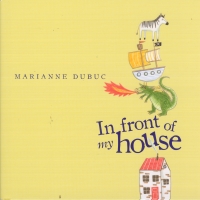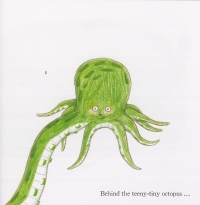| ________________
CM . . .
. Volume XVII Number 15. . . .December 10, 2010 
 |
In Front of My House.
Marianne Dubuc.
Toronto, ON: Kids Can Press, 2010.
120 pp., hardcover, $19.95.
ISBN 978-1-55453-641-2.
Subject Headings:
Space perception-Juvenile literature.
Vocabulary-Juvenile literature.
Kindergarten-grade 3 / Ages 5-8.
Review by Keith McPherson.
*** /4
|
| |
|

excerpt:
In front of my house…a rosebush.
On the rosebush…a little bird.
Above the little bird…a window.
Behind the window…my room.
In my room...my bed.
Under my bed…Wew! Nothing at all.
In Front of my House is a circular story (ends up where it began) that encourages readers to follow spatial patterns of thought and image that often lead to inventive surprises and creative twists of the imagination. Young children will particularly delight in trying to guess where the story will end up, while older children will be encouraged to look at the images in an effort to guess when and where the next surprise will be revealed.
Many of the pages in this visual romp contain images that can be logically predicted by young readers and will fall within their experiences (e.g., "On the edge of the pond…a bear fishing for breakfast. Behind the fishing bear…a bush. In the bush…a rabbit. Behind the rabbit…a family of rabbits"). However, adults may have to explain the connection between some pages when the story draws upon information and makes connection between this information that may not be within the child's experiences.
For example, after meeting the Big Bad Wolf that sits behind the family of rabbits, the child is introduced to a myriad of fairytale characters within the Big Bad Wolf's belly (characters such as the Three Little Pigs, the house made of bricks, the house made of straw, one of the seven little Kids, Peter, a pot full of stone soup, grandmother, and Little Red Riding Hood). However, unless the child has read the story of the Three Little Pigs, Little Red Riding Hood, and Peter and the Wolf, the connections may be less impactful.
 The story's language is simple and an excellent resource for reinforcing high frequency sight words that define relationships in space (words such as in, out, behind, in front, beside, up, down, under, over, on, and next to). Such words are essential to young children's future learning as they are used regularly in daily interactions. Teachers and parents can use this story as a springboard into, or a follow up after, a mini unit on spatial vocabulary. Low level ESL students will require a great deal of comprehensible input (e.g., visuals, physical demonstrations, etc) as the students encounter/re-encounter the story's spatial vocabulary, as such vocabulary and conce
The story's language is simple and an excellent resource for reinforcing high frequency sight words that define relationships in space (words such as in, out, behind, in front, beside, up, down, under, over, on, and next to). Such words are essential to young children's future learning as they are used regularly in daily interactions. Teachers and parents can use this story as a springboard into, or a follow up after, a mini unit on spatial vocabulary. Low level ESL students will require a great deal of comprehensible input (e.g., visuals, physical demonstrations, etc) as the students encounter/re-encounter the story's spatial vocabulary, as such vocabulary and conce
The illustrations are done in colourful pencil crayons. Characters and settings contain a touch of the iconic (cartoon-ish); however, readers will easily make connections with the objects and settings of their real worlds. Illustrations are clean and simple, and the pictures parallel and fully support the story's text. In some cases, the images help readers make their predictions (e.g., in the child's room a very ugly hand is opening the bedroom door which shapes our predictions of what we think might be under the bed on the next page).
Furthermore, both young and old will enjoy how Dubuc employs a post modern use of visuals to enrich the story. For example, Little Red Riding Hood simultaneously walks off one page while walking onto another which visually helps readers make the connection between the big bad wolf and the woodsman. Additionally, Dubuc writes the sound 'GRGRGRRRRRRR' in an increasing font that covers the two page spread which indicates a 'bigness' and 'loudness' of the terrifying growl of an abominable snowman we meet on the next page.
I read In Front of my House to a Kindergarten class, a grade three class and a small group of grade sevens. The K's thoroughly enjoyed trying to predict what the next page would contain, and the whole class continually raised their hands, eager to give their answers. The grade three's indicated they enjoyed the twists in the story, especially when the evil and dangerous characters turned up (e.g., the abominable snowman, the dragon, the big bad wolf), and they enjoyed creating/writing their own story in a similar format - especially if it ended with some type of unexpected monster. The grade sevens, on the other hand, thought the story was too long, and they did not find it scary. Obviously, this book is best enjoyed by primary students as recommended.
In Front of my House is a fun, predictive circular story that young children will follow with keen interest. It is a strong resource for introducing and reinforcing spatial vocabulary and for reinforcing reading strategies involving visual and textual-based predictions.
Recommended.
Keith McPherson has been a primary and elementary teacher and teacher-librarian in BC since 1984 and is currently a lecturer for the Department of Language and Literacy Education at the University of British Columbia in Vancouver, BC.

To comment
on this title or this review, send mail to cm@umanitoba.ca.
Copyright © the Manitoba Library Association. Reproduction for personal
use is permitted only if this copyright notice is maintained. Any
other reproduction is prohibited without permission.
NEXT REVIEW |
TABLE OF CONTENTS FOR THIS ISSUE
- December 10, 2010.
AUTHORS |
TITLES |
MEDIA REVIEWS |
PROFILES |
BACK ISSUES |
SEARCH |
CMARCHIVE |
HOME |

 The story's language is simple and an excellent resource for reinforcing high frequency sight words that define relationships in space (words such as in, out, behind, in front, beside, up, down, under, over, on, and next to). Such words are essential to young children's future learning as they are used regularly in daily interactions. Teachers and parents can use this story as a springboard into, or a follow up after, a mini unit on spatial vocabulary. Low level ESL students will require a great deal of comprehensible input (e.g., visuals, physical demonstrations, etc) as the students encounter/re-encounter the story's spatial vocabulary, as such vocabulary and conce
The story's language is simple and an excellent resource for reinforcing high frequency sight words that define relationships in space (words such as in, out, behind, in front, beside, up, down, under, over, on, and next to). Such words are essential to young children's future learning as they are used regularly in daily interactions. Teachers and parents can use this story as a springboard into, or a follow up after, a mini unit on spatial vocabulary. Low level ESL students will require a great deal of comprehensible input (e.g., visuals, physical demonstrations, etc) as the students encounter/re-encounter the story's spatial vocabulary, as such vocabulary and conce